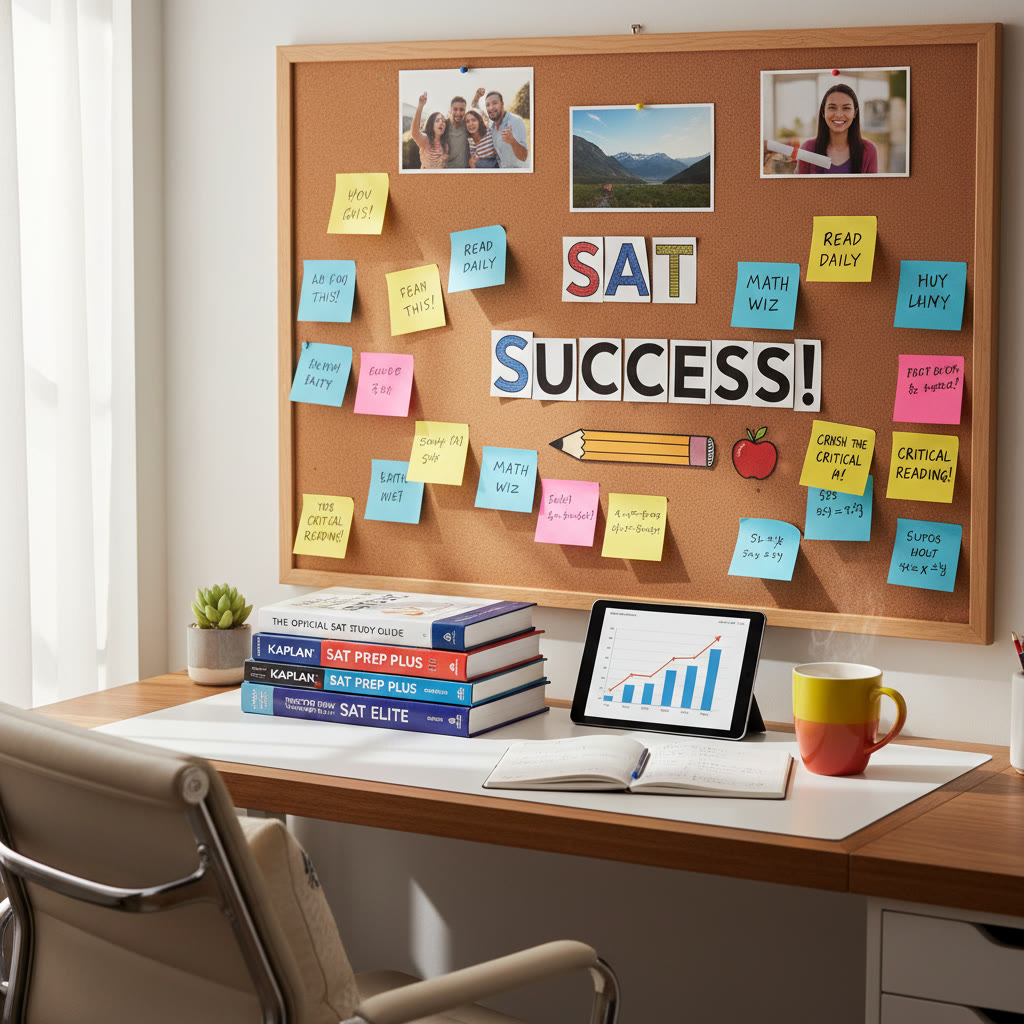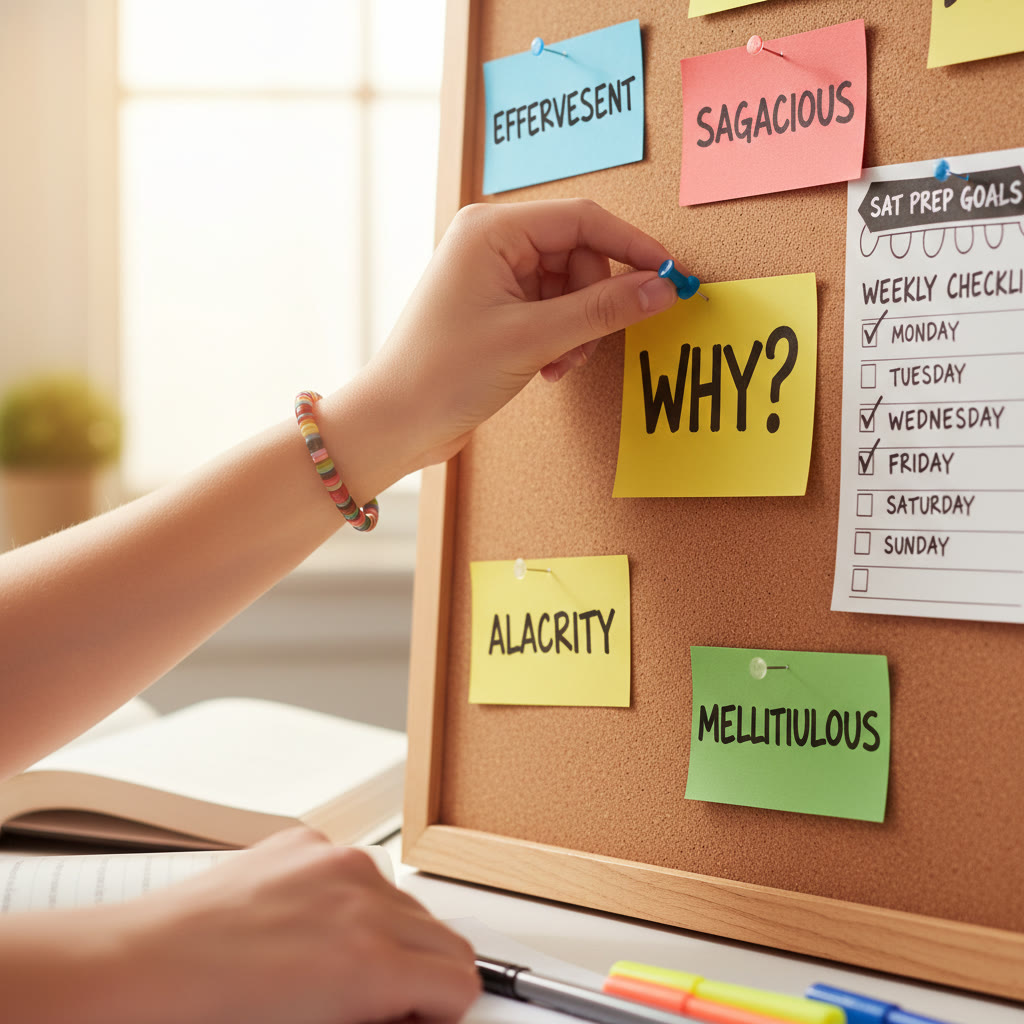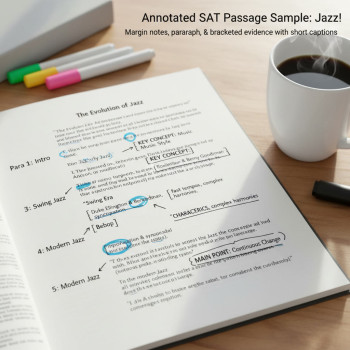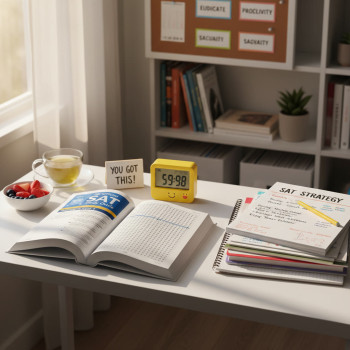Why a “Why I’m Preparing” Motivation Wall Actually Works
Think of your brain like a garden. What you plant, water, and check on regularly grows. A “Why I’m Preparing” motivation wall is a deliberate patch of that garden — visual, tangible, and personal. For SAT students, who face months of practice, timed sections, and the creeping doubt of “Am I doing the right thing?”, a motivation wall serves as a hub: it reminds you of the long-term why, tracks small wins, and pulls emotional energy back into the study routine when you’re exhausted or distracted.
There’s good psychological science behind this. Visual cues increase intention stability, small visible wins activate reward circuits in the brain, and frequent reminders help convert abstract goals (like “get a 1400”) into daily choices (like “practice 30 minutes of math now”). In plain terms: a wall that reflects your reasons and progress makes you more likely to keep going.
The mental mechanics: identity, cues, and momentum
Three simple mechanisms explain why this works:
- Identity anchoring: When you read a line like “I study because I want to become a civil engineer,” that statement trains you to see yourself as a student heading to engineering school. Identity is a powerful motivator.
- Environmental cues: The wall is a cue that nudges behavior. Seeing a study checklist or a short encouragement note triggers action without heavy decision-making.
- Momentum from micro-wins: Checking off a small task on the wall delivers dopamine. Regular micro-wins compound into larger performance gains.
Materials and Setup: Where and What
Choosing the perfect spot
Placement matters. Your wall should be where you study or pass frequently—near your desk, on a hallway you walk every morning, or on a bedroom wall that you see before bed. Avoid locations that are too public or likely to be tidied away by others.
Brightness and visibility are key. If you’re a night owl, make sure it’s visible in artificial light; if you study early, sunlight can be energizing. The point is familiarity: the wall should be part of your daily landscape.
Essential and optional materials
- Poster board, corkboard, or magnetic whiteboard
- Index cards, sticky notes (various colors)
- Pens, highlighters, washi tape for color coding
- Small pins, magnets, or adhesive putty
- Printed photos, college logos, scholarship target amounts
- Timer or small countdown calendar
- Optional: a small shelf or envelope for “letters from future you” and a tiny jar for reward slips

Build It Step-by-Step
Step 1 — Start by defining the “Why”
Before you pin anything, take 15–20 minutes to answer a few prompts in a notebook. Your answers will become the centerpiece of the wall. Useful prompts include:
- “Why am I preparing for the SAT?” (Be specific: not just “college,” but which majors, scholarships, or personal dreams.)
- “What will my life look like if I hit my target score?”
- “Who am I doing this for — myself, family, future teammates?”
- “What would it feel like to open an acceptance letter?”
Turn the best, most emotional sentences into large visible statements on your wall — handwritten or printed. These are core reminders on hard days.
Step 2 — Collect meaningful items
Every item on your wall should serve a purpose: remind, inspire, instruct, or track. Mix emotional artifacts (photos, letters) with practical ones (timed goals, vocabulary index).
- Photos: a campus you love, a mentor, a younger self who started this journey — aim for images that evoke emotion.
- Target visuals: your target SAT score, a benchmark score to beat, and a scholarship amount or program requirement you’re aiming for.
- Short motivational quotes in your voice, not generic slogans. Try: “I study with curiosity, not fear” or “One harder practice today = one easier test tomorrow.”
- Error log snippets: a small area where you pin a short summary of recurring mistakes (e.g., “algebra sign errors”) to address that week.
Step 3 — Design and layout
Design the wall so it’s scannable at a glance. Use zones (left-to-right or top-to-bottom) to separate long-term vision from short-term tasks.
- Vision zone: Large statements, photos, “future you” letters.
- Progress zone: Scoreboard, weekly checklist, reward jar.
- Action zone: Daily tasks, vocabulary flashcards, mini-timers stuck to the board.
| Zone | Purpose | Sample Items | Review Frequency |
|---|---|---|---|
| Vision | Anchor long-term reasons | College logo, “why” statement, future letter | Weekly |
| Progress | Track momentum and small wins | Scoreboard, mini milestones, reward slips | Daily |
| Action | Convert motivation into tasks | Daily checklist, 30-min timers, vocabulary snippets | Before every study session |
What to Put on the Wall: Specific Content Ideas
It’s easy to default to generic quotes. Instead, curate content that connects emotion to action. Here are categories with concrete ideas.
1. Personal “Why” statements
- “I’m prepping to have the options to choose from the universities I love.”
- “I want to study environmental engineering and create sustainable cities.”
- Handwritten notes from people who support you (parents, teachers) — short and specific.
2. Quantified targets and checkpoints
Numbers are clarifying. Don’t just list a vague goal; set mini-goals with dates. Example:
- Target score: 1450 by October
- Practice tests: Complete 12 full tests before test day
- Weekly actions: 4 math sections, 3 reading sections, and 2 essay outlines per week
3. Process-focused prompts
Process prompts keep you from fixating on outcomes and teach you to value the work itself. Put these on the action zone:
- “What confusion can I resolve in today’s 30 minutes?”
- “Which one concept will I drill until it’s easy?”
4. Micro-habits and trackers
Small habits build into a reliable routine. Consider a 30-day mini-tracker for a habit like “20 vocab words reviewed daily” or “one timed math section three times a week.” Use checkboxes or sticky notes you move from “To Do” to “Done.”
5. Error log and fix plan
Pin a small card that lists the three most common errors you made on a practice test — then list a single action for each (e.g., “When algebra signs confuse me, slow down and rewrite the equation”). The trick is specificity.
Maintenance: Keep the Wall Alive Without Burning Out
Daily rituals that are short and effective
- 2-minute morning glance: read your top “why” and one micro-task for the day.
- End-of-session sticker: after each study block, add a small sticker to a weekly tracker — visible accumulation is motivating.
- Sundown reflection: three things you did well that day and one improvement for tomorrow.
Weekly refresh
Once a week, spend 20–30 minutes with the wall. Move items around, replace a stale quote, add a new vocabulary card, and update your scoreboard. This ritual prevents the wall from becoming background noise and keeps your goals aligned with what’s actually happening in practice tests.
Measuring Progress: From Feelings to Facts
Motivation feels good, but performance is measurable. Combine emotional reminders with objective metrics so you can adjust study tactics sensibly.
- Keep a running scoreboard for practice tests (date, score, top three mistakes).
- Set weekly process KPIs (key performance indicators) like “5 timed reading passages” or “20 algebra problems reviewed.”
- Use small rewards for hitting KPIs — a coffee, a movie night, or a 30-minute social break.
How to Pair the Wall with Tutoring — Using Sparkl’s Personalized Tutoring
A motivation wall is most powerful when paired with guidance. Sparkl’s personalized tutoring can help you refine the “why,” translate it into a tailored study plan, and use AI-driven insights to focus on your weakest areas. Imagine pinning a tutor’s weekly plan on your wall: specific drills, targeted feedback, and small assignments aligned with your visual motivators.
Natural ways tutors can support your wall
- Help craft precise “why” statements that resonate emotionally and practically.
- Use session data to create short action cards for the wall — for example: “This week: review quadratic formula mistakes (10 problems).”
- Offer accountability: your tutor checks the wall’s progress points during sessions and updates the plan based on AI-driven performance analysis.
Pairing the wall with 1-on-1 guidance means your motivation is not just aspirational; it’s connected to expert direction. Sparkl’s expert tutors can interpret practice-test patterns and suggest focused micro-tasks to pin on the wall — an efficient loop of action and reinforcement.
A Short Case Study: Maya’s Motivation Wall
Maya, a rising senior, wanted a top-10% SAT score to qualify for a scholarship and ease her parents’ financial stress. She built a wall based on three pillars: family, scholarship, and a future major in public policy.
Maya’s wall had a big central “why”: a handwritten note she wrote to her future-self who had graduated. Around it she placed a scoreboard, weekly action cards, and a visible “error log” that listed recurring critical reading mistakes. Every Sunday, she and her Sparkl tutor spent 15 minutes updating the wall together — turning test analytics into three attackable tasks for the week.
Over three months, Maya’s practice test scores climbed 120 points. The wall helped her stay emotionally invested, while the tailored tutoring ensured her energy targeted the right skills.
Troubleshooting Common Pitfalls
1. When the wall becomes cluttered
Too many items dilute focus. Keep a “less is more” rule: three things you must see every day (why, today’s action, and a one-line scoreboard). Archive others into a folder or box to rotate weekly.
2. When motivation fades
Motivation naturally fluctuates. If your wall feels stale, swap the big “why” statement for a fresh one written in a different tone — cheeky, fierce, or tender — and add a new photo or a short letter from a friend reminding you of progress.
3. Comparison and social pressure
A wall is for you, not for show. Avoid pinning items that invite comparison (like friends’ scores) unless those items are strictly for personal data tracking. If you find yourself comparing, move those items to a private folder and focus the wall on your path.
Starter Templates: Quick Things You Can Pin Today
Here are immediate, actionable templates you can create in 30 minutes.
| Template | How to Use | Example Text |
|---|---|---|
| One-line “Why” | Center of the wall, visible daily | “So I can study environmental engineering and build sustainable cities. — Me, age 17” |
| Weekly Action Card | Rotate each week, pinned to Action zone | “This week: 3 timed readings, 2 math sections, 20 vocab words review.” |
| Error Fix Card | Attach near study desk for immediate reference | “When I miss inference q’s: underline the main claim and eliminate extremes.” |
Final Pep Talk: Make It Yours
A motivation wall is not a classroom poster or a to-do list: it’s a living map of your intention. Fill it with honest reasons, small executable tasks, and a few items that make you smile. Pair it with real-world feedback — either from your own practice tests or with Sparkl’s personalized tutoring — and you’ll turn abstract aspirations into steady progress.
Start simple: write one true “why,” add one weekly action, and pin one small victory. When those three things live in your space every day, choices get easier and momentum follows. Remember: the wall is a tool, not a miracle. Its real power is in the daily rituals it encourages and the clarity it brings to each study session. Now go make that wall — and give yourself the daily reminders you deserve.













No Comments
Leave a comment Cancel